
|
|
|
Editor in Chief Shmuel Spector, Consulting Editor Geoffrey Wigoder, New York University Press, New York, 2001. |
|
|
|
ROKISKIS (Yid. Rakishok) Rokiskis district, Lithuania. Jews first settled in the late 18th century, at the invitation of the local proprietor’s business manager. The Jewish population in 1897 was 2,067 (75% of the total). During WWI many left for Russia. Those who remained were seized for forced labor by the Germans. After the war, some Jews returned and others from surrounding areas moved there, leading to a short period of development. Economic conditions deteriorated partly because of the nationalization of trade in linen and grain and the establishment of a Catholic bank which helped Lithuanians undercut the prices of Jewish merchants. In 1925 many Jews went bankrupt, resulting in emigration to South Africa, the U.S., and Palestine. Jews were active in municipal politics and filled such positions as mayor and deputy mayor at different periods. The Jewish population in 1923 was 2,013 (46.5%). The community maintained two yeshivot and four Hebrew schools. Most of the Jews were Habad Hasidim. In 1939 the Jewish population was about 3,500 (40%). Among the noted natives was Yaacov Shmushkevich, who became the commander of the Soviet air force and executed for alleged treason in 1941. Y. Harmatz, a Vilna ghetto activist, was the director of World ORT. At the German invasion in June 1941, Jewish men were separated from the women and children; both groups were taken to forced labor. Between 14 and 25 August 1941 all were herded into pits outside the town and shot. |
Copyright RokiskisSIG 2022
